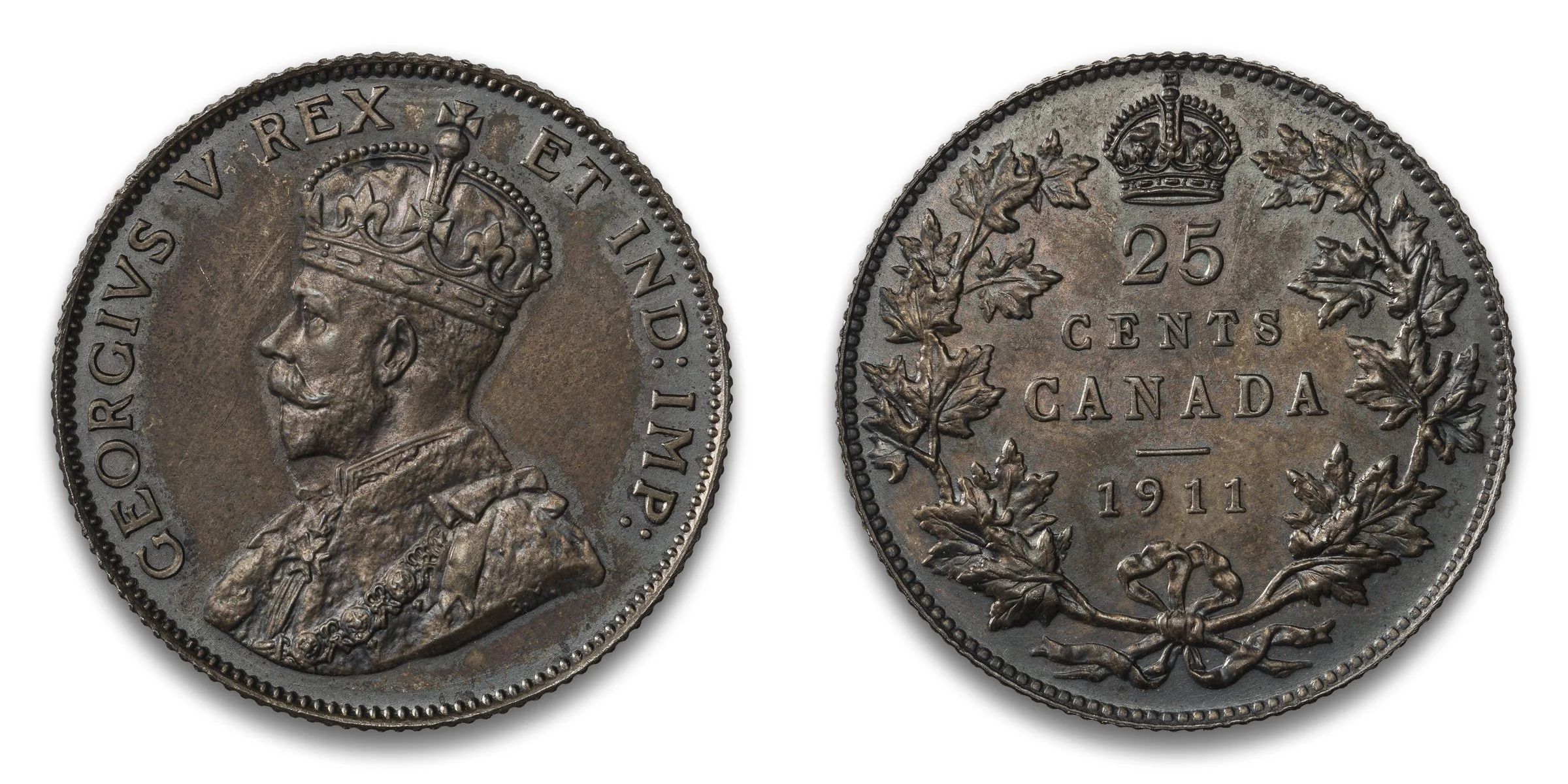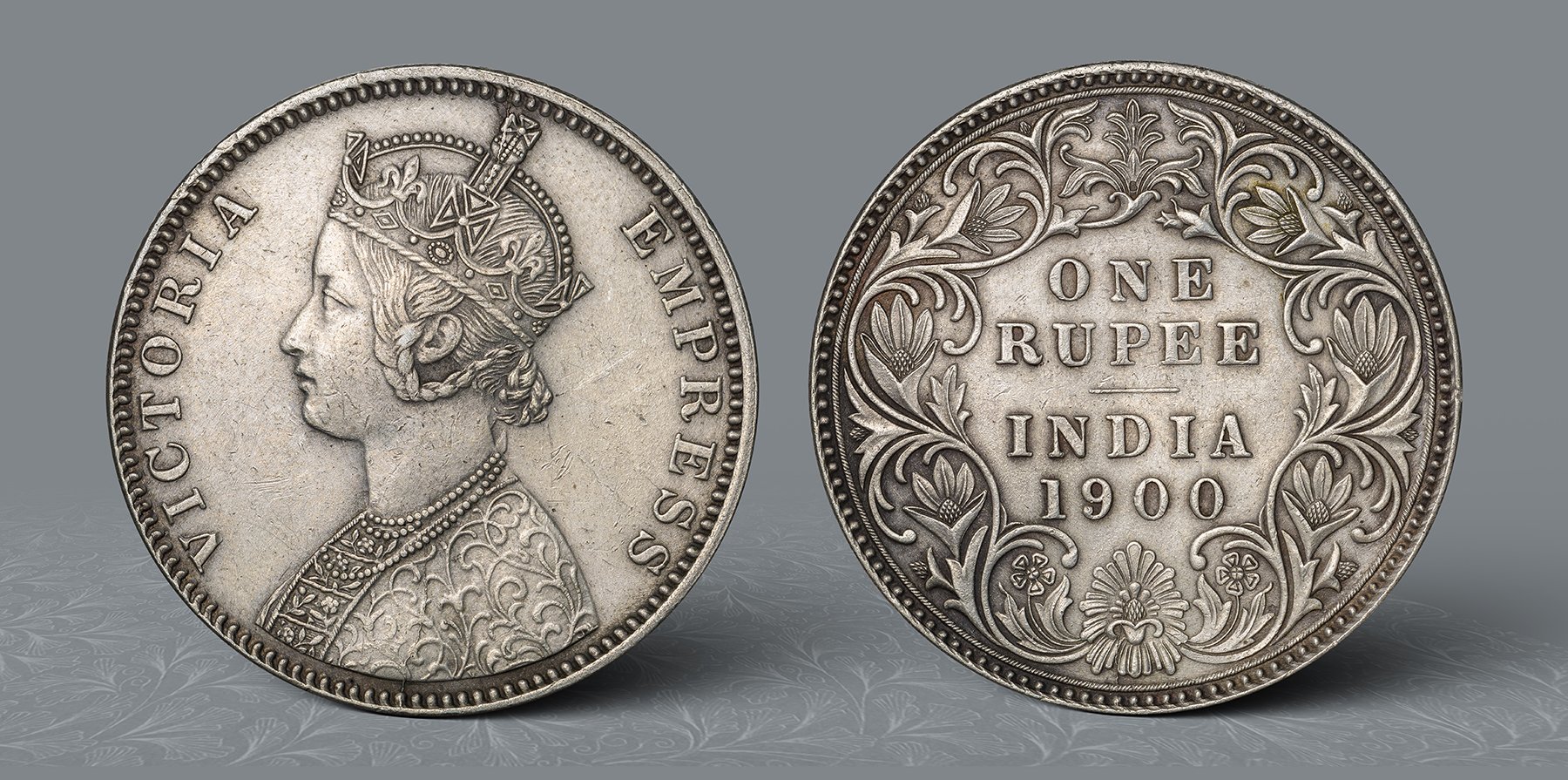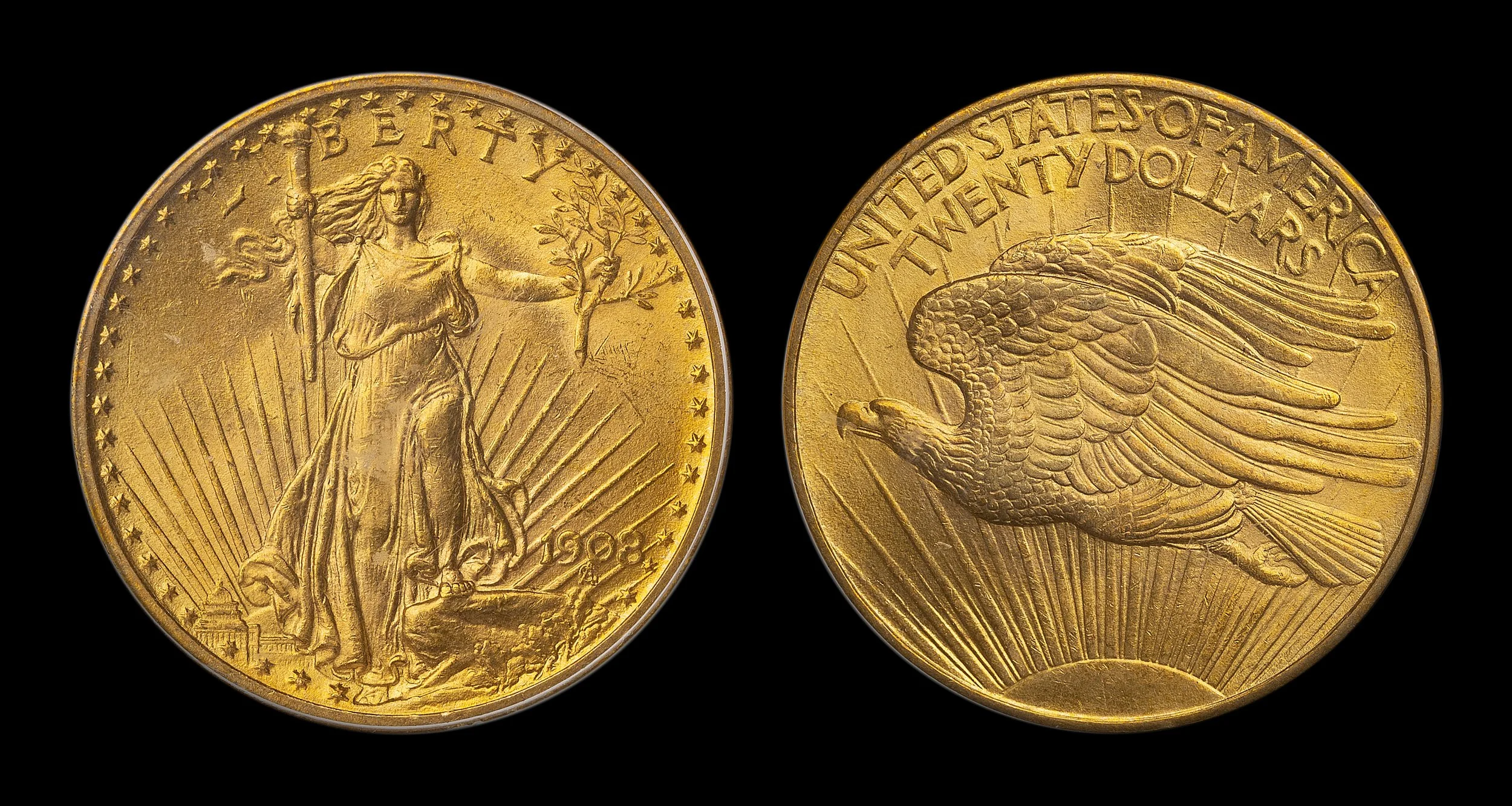The Godless Coins: When Money Lost Its "Grace"
By Denis Richard, Coin Photography Studio
May 11, 2025
7-minute read
A Curious Case in 1911: Canada's 'Godless' Coins
Imagine it’s 1911 in Canada. You pull a brand-new coin from your pocket and notice something odd about the inscription. Every Canadian coin you’ve ever seen bears the Latin letters D.G, an abbreviation of “Dei Gratia”, meaning “by the Grace of God,” as part of the monarch’s title – but on this 1911 coin, the letters are missing. In its place, the coin’s legend simply reads “REX ET IND: IMP” (Latin for “King and Emperor of India”). This subtle omission might not sound earth-shattering, but in 1911 it created a small firestorm. Canadians who noticed the absent Dei Gratia were perplexed and even upset – so much so that these coins quickly earned a nickname: the “Godless” coins.
Obverse of a “Godless” 1911 Canadian 25-cent coin. Image by Coin Photography Studio.
How did this happen? The story goes that when King George V succeeded to the throne in 1910, new coin designs had to be prepared in a hurry for Canada. The task of engraving the king’s titles onto small coins was tricky, and the Royal Mint engravers in London were under great pressure to get the dies ready for George V’s coronation year. In their haste – or perhaps thinking there simply wasn’t enough room – they accidentally left out “DEI GRATIA” on the dies for all the 1911 Canadian denominations. Even Canada’s own Finance Minister at the time, William Fielding, missed this detail when he approved the designs, so the coins were struck and put into circulation without the familiar phrase.
At first, many people likely didn’t spot the difference – but those who did were astonished. After all, Canadian coins (like British ones) had always included a reference to God as part of the monarch’s title. It was part of the symbolism people expected on their money. Before long, newspapers and citizens began voicing disapproval of the new “graceless” coins (as some politely called them). It wasn’t the portrait of the new king that bothered anyone – it was that the Almighty had been left off the currency.
Public Outrage in a Devout Era
The reaction to Canada’s 1911 godless coins was swift and loud. For a dominion of the British Empire in the Edwardian era, this omission felt like a breach of tradition – even borderline sacrilege to more religious folks. Remember, in 1911 Canada was a society where church-going was commonplace and the monarchy was closely tied to Christian identity. The phrase “by the Grace of God” wasn’t just decoration; it signified that the king ruled with divine approval. Dropping those two little Latin words struck a nerve.
The controversy grew so heated that officials scrambled to address it. By the end of 1911 (only months after the coins’ release), the new government of Sir Robert Borden took action. On December 29, 1911, a royal proclamation was issued to restore the words “Dei Gratia” to all Canadian coinage going forward. The very next year, 1912, Canada’s coins once again bore the traditional tribute to God’s grace – crisis averted.
The 1911 pieces themselves, however, quickly became a part of folklore. Collectors held onto them, and people would later recount how “the 1911 coins have come to be known as ‘graceless’” or godless in Canadian numismatic history. There was even speculation that the uproar contributed to the delay (and eventual cancellation) of a planned 1911 Canadian silver dollar, since authorities were wary of issuing high-profile coins amidst the slogan controversy. Whether or not that’s true, it’s clear the public outcry left its mark – literally – on all subsequent Canadian coin designs.
Why Put God on Coins in the First Place?
To modern eyes, it might seem peculiar that a tiny Latin inscription could cause such angst. But to understand the reaction, we need to appreciate why “Dei Gratia” was on the coins in the first place. The tradition of invoking God on coinage dates back centuries and is rooted in the concept of the divine right of kings. Monarchs in Britain and many other countries styled themselves as ruling by the grace of God – in other words, their authority was seen as granted by God, not merely by human whim.
The D G in the legend of this 1542 silver coin is an abbreviation of “Dei Gratia”. Image by Coin Photography Studio.
Because of this, British (and Canadian) coins had long carried phrases like “Dei Gratia Rex” or “Dei Gratia Regina” as part of the monarch’s title. This wasn’t just ornamental; it was a statement of legitimacy and faith. Queen Victoria’s coins, for example, read “VICTORIA DEI GRATIA” around her portrait, reinforcing that connection between the Crown and divine sanction. Given this history, it’s no surprise that by 1911 Canadians were thoroughly used to seeing a nod to God on their coinage.
Colonial Coins Without Grace: A Global Double Standard?
While Canadians were up in arms about the missing "Dei Gratia" in 1911, many other British colonies had never featured it on their coins in the first place, and barely anyone raised an eyebrow.
Take a look at coins minted for British West Africa, Ceylon (modern-day Sri Lanka), and Hong Kong, for instance. These regions were under British rule, and yet their coins, despite bearing the reigning monarch’s portrait, often did not include “Dei Gratia” at all.
Let’s break that down with a few examples:
Cyprus issued coins like the bronze penny above under Queen Victoria and Edward VI, and routinely omitted “Dei Gratia.” The coins featured the monarch’s name and title, often ending at “Queen” or “King and Emperor.” Image by Coin Photography Studio.
East African coinage, especially from the 1920s through 1940s, followed a similar pattern. The 1 shilling coins under George V and George VI frequently bore inscriptions like “GEORGE V KING AND EMPEROR OF INDIA”—again, no divine attribution. Image by Coin Photography Studio.
In India, the copper and silver coinage under Queen Victoria and Edward VII routinely omitted “Dei Gratia.” The coins featured the monarch’s name and title, often ending at “Queen” or “King and Emperor.” Image by Coin Photography Studio.
This begs the question: Why the double standard?
Part of it comes down to perceived audience. In dominions like Canada and Australia, largely populated by British settlers, the coinage traditions of the homeland were expected to be upheld in full. The omission of Dei Gratia in Canada touched a nerve precisely because it was seen as breaking with “civilized” British custom.
In contrast, colonies with large non-Christian or ethnically diverse populations were often given simpler, more functional coin designs—fewer words, less symbolism, and no Latin. These coins were meant to circulate widely without provoking confusion or resistance. The religious phrasing, which might not resonate with local populations, was discreetly omitted.
So when Canadians objected to their godless coins in 1911, it wasn’t really about the coin—it was about identity, tradition, and the expectation that they were a part of the British fold. Meanwhile, colonial subjects had long used “graceless” currency without complaint or consultation.
The Original "Godless" Coin: Victoria’s Florin of 1849
Interestingly, the Canadian “godless” coins of 1911 were not the first time a missing reference to God caused a stir. Over sixty years earlier, in 1849, Britain had its own run-in with a godless coin. That year, Queen Victoria’s government introduced a new coin denomination – the florin (worth two shillings) – as a step toward decimalizing British currency. The florin’s design was beautiful and modern, but one thing was missing: the usual “DEI GRATIA” inscription was nowhere to be found on the coin’s obverse.
The press dubbed the new florin “the Godless Florin,” and there was a genuine public outcry over the omission. To Victorian minds, it was as if the coin had “dethroned” the Almighty by not acknowledging God’s grace. The uproar was loud enough that the Royal Mint quickly revised the design. By 1851, just two years later, the words Dei Gratia were restored to Britain’s coinage.
1849 Victoria 'Godless' Florin. This infamous coin features the 'Gothic Portrait' of Queen Victoria- Image from the Royal Mint https://www.royalmint.com/shop/monarch/queen-victoria/1849-Victoria-Godless-Florin/
Collectors today still remember the “Godless Florin” as a historical curiosity – a coin that taught the Royal Mint a lesson about Victorian public opinion. And maybe, just maybe, someone in Ottawa should have remembered that story before finalizing those 1911 dies.
Roosevelt’s “Godless” Gold Coins: A Different Kind of Controversy
Canada wasn’t the only country to face backlash over removing God from its coinage. Just a few years earlier, the United States had its own “godless coin” moment—and this one started right at the top.
In 1907, President Theodore Roosevelt personally commissioned renowned sculptor Augustus Saint-Gaudens to redesign America’s $10 and $20 gold coins. The result was the stunning Indian Head Eagle and the now-iconic Saint-Gaudens Double Eagle—masterpieces of American coin design.
However, there was one major omission: the absence of “In God We Trust.”
Image by Coin Photography Studio.
This wasn’t a mistake. Roosevelt specifically instructed Saint-Gaudens to omit the motto. Why? The president believed that placing such a sacred phrase on money, used in gambling, crime, and everyday commercial exchange, cheapened its meaning.
In a letter dated November 1907, Roosevelt wrote:
“To put such a motto on coins, or to use it in any kindred manner, not only does no good, but does positive harm… Any use which tends to cheapen it… is from every standpoint profoundly to be regretted... I have never heard any human being speak reverently of this motto on the coins… but I have literally, hundreds of times, heard it used as an occasion of and incitement to sneering.”
Roosevelt even cited satirical headlines, such as “In God We Trust for the 8 cents,” as proof that the phrase was being used more for sarcasm than solemnity. Still, the omission didn’t sit well with the public—or with Congress. The backlash was immediate. Critics decried the new gold coins as “godless” and accused Roosevelt of undermining American values.
By early 1908, Congress passed a coinage act requiring that “In God We Trust” be restored to all U.S. gold and silver coins. On July 1, 1908, the motto officially returned to the $10 and $20 gold pieces. Future coins followed suit:
The Lincoln cent (1909) featured the motto from the start.
The Mercury dime (1916) and Jefferson nickel (1938) carried it as well.
Since 1938, every U.S. coin denomination has included “In God We Trust.”
So while Canada’s “godless” 1911 coins were accidental, Roosevelt’s were deliberate. Yet in both cases, the absence of a few sacred words on money sparked public outrage, legislative action, and a lasting place in numismatic history.
Coins Without God: A Wider Perspective
Not every country cares about religious inscriptions on coins—and some never have. The U.S. famously added “In God We Trust” during the Civil War, but in 1907, President Theodore Roosevelt tried to leave it off a new $20 gold coin. The backlash was instant. Americans, like Canadians, expected to see God on their money.
Interestingly, most countries issue coins without any religious inscriptions:
Japan, China and Mexico, featured above, have never included God's name on standard currency.
France removed religious references after its Revolution in 1799, and its coins today bear the inscription "Liberté, Égalité, Fraternité" instead. Image by Coin Photography Studio.
Even Vatican City’s euro coins don't explicitly name God on the face of the coins! Today, only the Netherlands retains a religious motto on modern currency: “God zij met ons” (“God be with us”), engraved along the edge of some Dutch euro coins.
In most parts of the world, a “godless coin” isn’t a scandal — it’s normal.
How Other Countries Used (and Dropped) “Dei Gratia” on Their Coins
The story of Dei Gratia on coins wasn’t just a British and Canadian phenomenon. Across the world, several countries included (and later removed) religious references from their coinage—each reflecting different historical and political shifts.
Here’s a quick look at how the phrase evolved globally:
Australia
Australian coins included “Dei Gratia Rex” or “Dei Gratia Regina” in some form, often abbreviated, from the 19th century through 1964.
A notable example is the 1953 Australian half-penny, which prominently features 'Dei Gratia Regina’ around Queen Elizabeth II’s portrait.
When Australia adopted decimal coinage in 1966, the phrase “by the Grace of God” was formally dropped. Since then, no regular Australian coins have carried this phrase in their inscriptions.
Austria
Prior to 1918, coins of the Austrian Empire often included the initials D.G., short for Dei Gratia, alongside the emperor or empress's bust. After the fall of the empire following World War I, Austrian coinage dropped the religious title.
1823 Austrian Thaler with DG in the legend.
Canada (In Detail)
Canada’s use of Dei Gratia mirrored Britain’s traditions, mostly.
Queen Victoria’s reign (1837–1901): Canadian coins read Dei Gratia Regina.
Edward VII (1902–1910): Coins bore Dei Gratia Rex Imperator or abbreviated D:G Rex Imperator ("by the Grace of God, King and Emperor").
The 1911 “Godless Coins”: The Dei Gratia part was accidentally omitted, sparking a major public uproar (the focus of this article!).
George V (1911–1936): Coins read Dei Gra: Rex et Ind: Imp ("by the Grace of God, King and Emperor of India").
George VI (1937–1952): Used D:G:Rex et Ind:Imp, shortened after India's independence to just Dei Gratia Rex.
Elizabeth II (1953–1964): Coins returned to Dei Gratia Regina.
From 1965 onward: Canadian coins abbreviated it to D. G. Regina.
In November 2023, the Royal Canadian Mint unveiled new coins with King Charles III’s effigy, switching the inscription to D. G. Rex.
Some modern commemorative coins, like the 1976 Montreal Olympics coins and the 2010 Vancouver Olympics 25-cent pieces, notably omitted the phrase altogether.
Gold, silver, platinum, and palladium Maple Leaf bullion coins also leave out the monarch's title.
2024 Gold Maple Leaf. Image by Coin Photography Studio.
Cyprus
While under British rule, Cyprus coins carried Dei Gratia Rex or Dei Gratia Regina until 1952. After Queen Elizabeth II ascended the throne, the legend on Cypriot coins shifted from Latin to English, and the religious phrasing was dropped.
Hungary
As part of Austria-Hungary, Hungary issued its own coins after the 1867 Compromise. Instead of Latin, Hungarian coins bore I.K., an abbreviation for Isten Kegyelméből, meaning "by the grace of God" in Hungarian. The full phrase appeared only rarely.
Jersey (Channel Islands)
Coins from the Bailiwick of Jersey included Dei Gratia Rex (or Regina) and Fid. Def. ("Defender of the Faith") until 1952. Like Cyprus, Jersey dropped the Latin references when Queen Elizabeth II came to power.
Spain
Many Spanish coins before 1937 bore the phrase "por la gracia de Dios" ("by the grace of God").
Under Francisco Franco’s dictatorship (1939–1975), coins featured "Caudillo de España por la G. de Dios" ("Leader of Spain by the grace of God").
After the return of democracy in 1975, Spain dropped all religious references from its coins.
Sweden
During the 17th century, Swedish coins prominently referenced God's grace.
For example:
Queen Christina’s coins were inscribed CHRISTINA D.G.R.S. ("Christina, by the Grace of God, Queen of the Swedes").
King Karl XI coins and medals read CAROLVS XI DEI GRATIA SVEC GOTH VANDAL REX ("Charles XI, by God’s Grace, King of the Swedes, Goths, and Vandals").
Today, while Swedish coins often feature the monarch’s portrait, they no longer include religious inscriptions.
Final Thoughts on "Dei Gratia" in World Coinage
The inclusion—and gradual disappearance—of Dei Gratia from coins around the world mirrors how monarchies, national identities, and public values evolved through the 19th and 20th centuries. Where once divine right was proclaimed boldly on every coin, today’s money is more secular, reflecting modern ideas of governance and society. And in the case of the godless coins, that story just happens to involve a little less grace – and a lot more drama – than usual.
Thank you for reading this blog post! I hope you found it informative and enjoyable.
If you're interested in similar topics, be sure to check out our other posts on numismatic subjects. From coin history to coin photography, we have lots to offer.
Don't forget to leave a comment below with your thoughts and feedback. We love hearing from our readers, and it helps us improve our content.
Thank you again for your support, and we hope to see you back here soon! Happy collecting!











